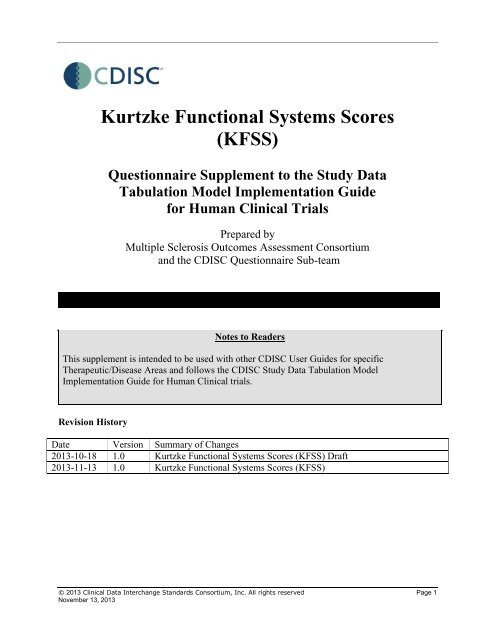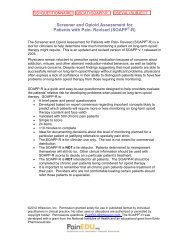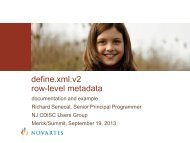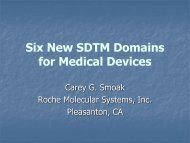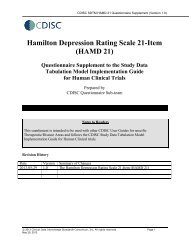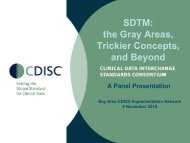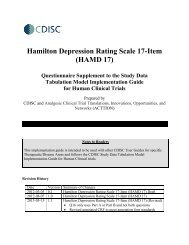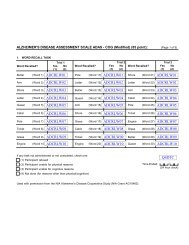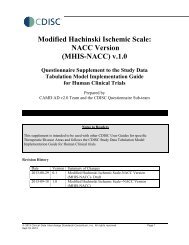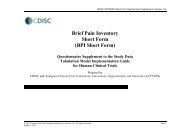Kurtzke Functional Systems Scores (KFSS)
SDTM QS - KFSS v1 Public Domain - CDISC Portal
SDTM QS - KFSS v1 Public Domain - CDISC Portal
- No tags were found...
Create successful ePaper yourself
Turn your PDF publications into a flip-book with our unique Google optimized e-Paper software.
<strong>Kurtzke</strong> <strong>Functional</strong> <strong>Systems</strong> <strong>Scores</strong><br />
(<strong>KFSS</strong>)<br />
Questionnaire Supplement to the Study Data<br />
Tabulation Model Implementation Guide<br />
for Human Clinical Trials<br />
Prepared by<br />
Multiple Sclerosis Outcomes Assessment Consortium<br />
and the CDISC Questionnaire Sub-team<br />
Notes to Readers<br />
This supplement is intended to be used with other CDISC User Guides for specific<br />
Therapeutic/Disease Areas and follows the CDISC Study Data Tabulation Model<br />
Implementation Guide for Human Clinical trials.<br />
Revision History<br />
Date Version Summary of Changes<br />
2013-10-18 1.0 <strong>Kurtzke</strong> <strong>Functional</strong> <strong>Systems</strong> <strong>Scores</strong> (<strong>KFSS</strong>) Draft<br />
2013-11-13 1.0 <strong>Kurtzke</strong> <strong>Functional</strong> <strong>Systems</strong> <strong>Scores</strong> (<strong>KFSS</strong>)<br />
© 2013 Clinical Data Interchange Standards Consortium, Inc. All rights reserved Page 1<br />
November 13, 2013
CDISC SDTM <strong>KFSS</strong> Questionnaire Supplement (Version 1.0)<br />
1 Introduction<br />
This document describes the CDISC implementation of the <strong>Kurtzke</strong> <strong>Functional</strong> <strong>Systems</strong> <strong>Scores</strong><br />
(<strong>KFSS</strong>) questionnaire, a standard questionnaire that is typically used in clinical trials to provide a<br />
standardized measure of global neurological impairment in Multiple Sclerosis.<br />
The <strong>KFSS</strong> questionnaire preceded the CDISC CDASH CRF standards and based on its public<br />
domain status, cannot be modified to CDASH standards.<br />
The representation of data collected for this questionnaire is based on the Study Data Tabulation<br />
Model Implementation Guide (SDTMIG) QS domain model, which can be found at the CDISC<br />
website at: (http://www.cdisc.org/sdtm).<br />
These specific implementation details for this questionnaire are meant to be used in conjunction<br />
with the SDTMIG. All questionnaire documentation can be found on the CDISC web site at:<br />
(http://www.cdisc.org/content2909).<br />
The CDISC Intellectual Property Policy can be found on the CDISC web site at:<br />
(http://www.cdisc.org/bylaws-and-policies).<br />
1.1 Representations and Warranties, Limitations of Liability, and Disclaimers<br />
This document is a supplement to the Study Data Tabulation Model Implementation Guide for<br />
Human Clinical Trials and is covered under Appendix F of that document, which describes<br />
representations, warranties, limitations of liability, and disclaimers. Please see Appendix F of<br />
the SDTMIG for a complete version of this material.<br />
2 Copyright Status<br />
This instrument is in the public domain. CDISC has included the <strong>Kurtzke</strong> <strong>Functional</strong> <strong>Systems</strong><br />
<strong>Scores</strong> (<strong>KFSS</strong>) as part of CDISC Data Standards. Hence, CDISC developed QSTESTCD and<br />
QSTEST for each question based on the actual question text on the questionnaire. There may be<br />
many versions of this questionnaire in the public domain. CDISC has chosen to use this version<br />
as the data standard. The <strong>Kurtzke</strong> <strong>Functional</strong> <strong>Systems</strong> <strong>Scores</strong> is commonly known as the FSS,<br />
but the QSCAT=<strong>KFSS</strong> to differentiate this from the Fatigue Severity Scale, which is also<br />
commonly known as the FSS.<br />
The CDISC documentation of this instrument consists of: (1) controlled terminology, (2)<br />
standard database structure with examples, and (3) case report forms annotated with the CDISC<br />
SDTMIG submission values.<br />
Note: CDISC controlled terminology is maintained by NCI EVS. The most recent version should<br />
be accessed through the CDISC website. (http://www.cdisc.org/terminology)<br />
The <strong>KFSS</strong> questionnaire is included in the following reference:<br />
<strong>Kurtzke</strong> JF. Rating neurologic impairment in multiple sclerosis: an expanded disability<br />
status scale (EDSS). Neurology. 1983 Nov;33(11):1444-52.<br />
© 2013 Clinical Data Interchange Standards Consortium, Inc. All rights reserved Page 2<br />
November 13, 2013
CDISC SDTM <strong>KFSS</strong> Questionnaire Supplement (Version 1.0)<br />
3 The QS Domain Model<br />
3.1 Assumptions for Questionnaire Domain Model<br />
All assumptions and business rules described in the SDTMIG QS domain are applicable to this<br />
supplement. Additional assumptions specific to the <strong>Kurtzke</strong> <strong>Functional</strong> <strong>Systems</strong> <strong>Scores</strong><br />
questionnaire are listed below.<br />
<strong>Kurtzke</strong> <strong>Functional</strong> <strong>Systems</strong> <strong>Scores</strong> (<strong>KFSS</strong>): The <strong>KFSS</strong> consists of 7 functional systems with an<br />
ordinal clinical rating scale for each. The functional systems included in the <strong>KFSS</strong> are the<br />
pyramidal, cerebellar, brainstem, sensory, bowel/bladder, visual, and cerebral functions. In<br />
addition to the functional system rating scales, there are 2 additional questions asking about<br />
weakness and temporal pallor, which could affect the ratings.<br />
1. The scale points include a rating (e.g. “0”) and a definition of what is represented by the<br />
rating (e.g. “Normal”). For <strong>KFSS</strong>, QSORRES is populated with the rating definition.<br />
QSSTRESC and QSSTRESN are populated with the numerical rating only.<br />
2. For item <strong>KFSS</strong>104, one of the rating definitions is longer than the 200 character limit<br />
currently mandated by the FDA, and hence, CDISC. The QS sub-team has paraphrased<br />
the text to shorten the responses. The original and modified values are summarized in<br />
Section 5.<br />
3. Items <strong>KFSS</strong>102A and <strong>KFSS</strong>106A have the instruction “record #1 in small box” when the<br />
subject has the specified condition (weakness, temporal pallor). If 1 is recorded in the<br />
box, QSORRES, QSSTRESC, and QSSTRESN have the value “1”. Otherwise, do not<br />
include a record for the item.<br />
4. The questionnaire evaluator is stored in QSEVAL. For <strong>KFSS</strong>, the evaluator is defined as<br />
INVESTIGATOR. Additional identifying information to further distinguish the rater in<br />
QSEVAL should be stored in QSEVALID. An example is rater initials.<br />
5. Terminology:<br />
a. QSCAT, QSTESTCD and QSTEST are approved CDISC controlled terminology.<br />
b. A full list of value sets for qualifier and result fields is provided in Section 4: SDTM<br />
Mapping Strategy.<br />
© 2013 Clinical Data Interchange Standards Consortium, Inc. All rights reserved Page 3<br />
November 13, 2013
CDISC SDTM <strong>KFSS</strong> Questionnaire Supplement (Version 1.0)<br />
3.2 Example for <strong>Kurtzke</strong> <strong>Functional</strong> <strong>Systems</strong> <strong>Scores</strong> (<strong>KFSS</strong>) QS Domain Model<br />
The <strong>KFSS</strong> example below shows the terminology used to implement the questionnaire in the QS domain. This example shows the data for one<br />
subject collected at the baseline visit for a <strong>KFSS</strong> questionnaire. The subject experienced weakness which interfered with the testing, but did not<br />
have temporal pallor. The example uses CDISC controlled terminology for QSTESTCD, QSTEST, and QSCAT. QSBLFL is Y based on<br />
VISITNUM=1. All original results are represented with preferred terminology in QSORRES. This result is then transformed into a standard<br />
numeric score in QSSTRESN and a character representation of the standard numeric score in QSSTRESC, with the exception of items <strong>KFSS</strong>102A<br />
and <strong>KFSS</strong>106A.<br />
Rows 1-8: Shows the questions from the <strong>KFSS</strong> form.<br />
Row 3: Shows the QSORRES, QSSTRESC, and QSSTRESN values of “1” since the subject experienced weakness which interfered with the<br />
testing. Note that since the subject did not have temporal pallor, a record for item <strong>KFSS</strong>106A is not created.<br />
qs.xpt<br />
Row STUDYID DOMAIN USUBJID QSSEQ QSTESTCD QSTEST QSCAT QSORRES QSSTRESC QSSTRESN<br />
1 STUDYX QS P0001 1 <strong>KFSS</strong>101 <strong>KFSS</strong>1-Pyramidal Functions <strong>KFSS</strong> Minimal disability 2 2<br />
2 STUDYX QS P0001 2 <strong>KFSS</strong>102 <strong>KFSS</strong>1-Cerebellar Functions<br />
3 STUDYX QS P0001 3 <strong>KFSS</strong>102A<br />
<strong>KFSS</strong>1-Weakness Interferes With<br />
Testing<br />
<strong>KFSS</strong><br />
<strong>KFSS</strong><br />
Severe ataxia in all limbs (most function is very<br />
difficult)<br />
4 4<br />
1 1 1<br />
4 STUDYX QS P0001 4 <strong>KFSS</strong>103 <strong>KFSS</strong>1-Brainstem Functions <strong>KFSS</strong> Normal 0 0<br />
5 STUDYX QS P0001 5 <strong>KFSS</strong>104 <strong>KFSS</strong>1-Sensory Function<br />
6 STUDYX QS P0001 6 <strong>KFSS</strong>105<br />
<strong>KFSS</strong>1-Bowel and Bladder<br />
Function<br />
7 STUDYX QS P0001 7 <strong>KFSS</strong>106 <strong>KFSS</strong>1-Visual Function<br />
8 STUDYX QS P0001 8 <strong>KFSS</strong>107<br />
<strong>KFSS</strong>1-Cerebral (or Mental)<br />
Functions<br />
<strong>KFSS</strong><br />
<strong>KFSS</strong><br />
<strong>KFSS</strong><br />
<strong>KFSS</strong><br />
Vibration or figure-writing decrease only in one or<br />
two limbs<br />
1 1<br />
Frequent urinary incontinence 3 3<br />
Grade 5 plus maximal visual acuity of better eye of<br />
20/60 or less<br />
6 6<br />
(Unknown) 9 9<br />
Row QSBLFL QSEVAL VISITNUM QSDTC<br />
1 (cont) Y INVESTIGATOR 1 2012-11-16<br />
2 (cont) Y INVESTIGATOR 1 2012-11-16<br />
3 (cont) Y INVESTIGATOR 1 2012-11-16<br />
4 (cont) Y INVESTIGATOR 1 2012-11-16<br />
5 (cont) Y INVESTIGATOR 1 2012-11-16<br />
© 2013 Clinical Data Interchange Standards Consortium, Inc. All rights reserved Page 4<br />
November 13, 2013
CDISC SDTM <strong>KFSS</strong> Questionnaire Supplement (Version 1.0)<br />
6 (cont) Y INVESTIGATOR 1 2012-11-16<br />
7 (cont) Y INVESTIGATOR 1 2012-11-16<br />
8 (cont) Y INVESTIGATOR 1 2012-11-16<br />
© 2013 Clinical Data Interchange Standards Consortium, Inc. All rights reserved Page 5<br />
November 13, 2013
CDISC SDTM <strong>KFSS</strong> Questionnaire Supplement (Version 1.0)<br />
4 SDTM Mapping Strategy<br />
<strong>KFSS</strong> specific mapping strategy: This section is used for reference with the annotated CRF for<br />
further details on the CRF data capture and to understand the alignment of the questionnaire to<br />
the SDTM QS domain. It also provides guidance on how the result variables (QSORRES,<br />
QSSTRESC, and QSSTRESN) should be populated for the questionnaire.<br />
QSTESTCD=<strong>KFSS</strong>101<br />
QSTEST=<strong>KFSS</strong>1-Pyramidal Functions<br />
QSORRES QSSTRESC QSSTRESN<br />
Normal 0 0<br />
Abnormal signs without disability 1 1<br />
Minimal disability 2 2<br />
Mild to moderate paraparesis or hemiparesis (detectable<br />
weakness but most function sustained for short periods,<br />
3 3<br />
fatigue a problem); severe monoparesis (almost no function)<br />
Marked paraparesis or hemiparesis (function is difficult),<br />
moderate quadriparesis (function is decreased but can be<br />
4 4<br />
sustained for short periods); or monoplegia<br />
Paraplegia, hemiplegia, or marked quadriparesis 5 5<br />
Quadriplegia 6 6<br />
(Unknown) 9 9<br />
QSTESTCD=<strong>KFSS</strong>102<br />
QSTEST=<strong>KFSS</strong>1-Cerebellar Functions<br />
QSORRES QSSTRESC QSSTRESN<br />
Normal 0 0<br />
Abnormal signs without disability 1 1<br />
Mild ataxia (tremor or clumsy movements easily seen, minor<br />
interference with function)<br />
2 2<br />
Moderate truncal or limb ataxia (tremor or clumsy<br />
movements interfere with function in all spheres)<br />
3 3<br />
Severe ataxia in all limbs (most function is very difficult) 4 4<br />
Unable to perform coordinated movements due to ataxia 5 5<br />
(Unknown) 9 9<br />
QSTESTCD=<strong>KFSS</strong>102A<br />
QSTESTCD=<strong>KFSS</strong>106A<br />
QSTEST=K<strong>KFSS</strong>1-Weakness Interferes With Testing<br />
QSTEST=K<strong>KFSS</strong>1-Presence of Temporal Pallor<br />
QSORRES QSSTRESC QSSTRESN<br />
1 1 1<br />
© 2013 Clinical Data Interchange Standards Consortium, Inc. All rights reserved Page 6<br />
November 13, 2013
CDISC SDTM <strong>KFSS</strong> Questionnaire Supplement (Version 1.0)<br />
QSTESTCD=<strong>KFSS</strong>103<br />
QSTEST=K<strong>KFSS</strong>1-Brainstem Functions<br />
QSORRES QSSTRESC QSSTRESN<br />
Normal 0 0<br />
Signs only 1 1<br />
Moderate nystagmus or other mild disability 2 2<br />
Severe nystagmus, marked extraocular weakness, or<br />
moderate disability of other cranial nerves<br />
3 3<br />
Marked dysarthria or other marked disability 4 4<br />
Inability to swallow or speak 5 5<br />
(Unknown) 9 9<br />
QSTESTCD=<strong>KFSS</strong>104<br />
QSTEST=K<strong>KFSS</strong>1-Sensory Function<br />
QSORRES QSSTRESC QSSTRESN<br />
Normal 0 0<br />
Vibration or figure-writing decrease only in one or two<br />
limbs<br />
1 1<br />
Mild decrease in touch or pain or position sense, and/or<br />
moderate decrease in vibration in one or two limbs; or<br />
vibratory (c/s figure writing) decrease alone in three or four<br />
2 2<br />
limbs<br />
Moderate decrease in touch or pain or position sense, and/or<br />
lost vibration in 1 or 2 limbs; or mild decrease in touch or<br />
pain and/or moderate decrease in all proprioceptive tests in 3<br />
3 3<br />
or 4 limbs<br />
Marked decrease in touch or pain or loss of proprioception,<br />
alone or combined, in one or two limbs; or moderate<br />
decrease in touch or pain and/or severe proprioceptive<br />
4 4<br />
decrease in more than two limbs<br />
Loss (essentially) of sensation in one or two limbs; or<br />
moderate decrease in touch or pain and/or loss of<br />
5 5<br />
proprioception for most of the body below the head<br />
Sensation essentially lost below the head 6 6<br />
(Unknown) 9 9<br />
QSTESTCD=<strong>KFSS</strong>105<br />
QSTEST=K<strong>KFSS</strong>1-Bowel and Bladder Function<br />
QSORRES QSSTRESC QSSTRESN<br />
Normal 0 0<br />
Mild urinary hesitance, urgency, or retention 1 1<br />
Moderate hesitance, urgency, retention of bowel or bladder,<br />
or rare urinary incontinence (intermittent selfcatheterization,<br />
manual compression to evacuate bladder, or<br />
2 2<br />
finger evacuation of stool)<br />
Frequent urinary incontinence 3 3<br />
In need of almost constant catheterization (and constant use<br />
of measures to evacuate stool)<br />
4 4<br />
© 2013 Clinical Data Interchange Standards Consortium, Inc. All rights reserved Page 7<br />
November 13, 2013
CDISC SDTM <strong>KFSS</strong> Questionnaire Supplement (Version 1.0)<br />
Loss of bladder function 5 5<br />
Loss of bowel and bladder function 6 6<br />
(Unknown) 9 9<br />
QSTESTCD=<strong>KFSS</strong>106<br />
QSTEST=K<strong>KFSS</strong>1-Visual Function<br />
QSORRES QSSTRESC QSSTRESN<br />
Normal 0 0<br />
Scotoma with visual acuity (corrected) better than 20/30 1 1<br />
Worse eye with scotoma with maximal visual acuity<br />
(corrected) of 20/30-20/59<br />
2 2<br />
Worse eye with large scotoma, or moderate decrease in<br />
fields, but with maximal visual acuity (corrected) of 20/60-<br />
3 3<br />
20/99<br />
Worse eye with marked decrease of fields and maximal<br />
visual acuity (corrected) of 20/100-20/200; grade 3 plus<br />
4 4<br />
maximal acuity of better eye of 20/60 or less<br />
Worse eye with maximal visual acuity (corrected) less than<br />
20/200; grade 4 plus maximal acuity of better eye of 20/60<br />
5 5<br />
or less<br />
Grade 5 plus maximal visual acuity of better eye of 20/60 or<br />
less<br />
6 6<br />
(Unknown) 9 9<br />
QSTESTCD=<strong>KFSS</strong>107<br />
QSTEST=K<strong>KFSS</strong>1-Cerebral (or Mental) Functions<br />
QSORRES QSSTRESC QSSTRESN<br />
Normal 0 0<br />
Mood alteration only (does not affect EDSS score) 1 1<br />
Mild decrease in mentation 2 2<br />
Moderate decrease in mentation 3 3<br />
Marked decrease in mentation (chronic brain syndrome –<br />
moderate)<br />
4 4<br />
Dementia or chronic brain syndrome – severe or<br />
incompetent<br />
5 5<br />
(Unknown) 9 9<br />
© 2013 Clinical Data Interchange Standards Consortium, Inc. All rights reserved Page 8<br />
November 13, 2013
CDISC SDTM <strong>KFSS</strong> Questionnaire Supplement (Version 1.0)<br />
5 Original and QSORRES Comparison- QSTESTCD=<strong>KFSS</strong>104<br />
QSSTRESN K<strong>KFSS</strong>1-Sensory Function (Original) QSORRES Value<br />
0 Normal Normal<br />
Vibration or figure-writing decrease only in one or Vibration or figure-writing decrease<br />
1<br />
two limbs<br />
only in one or two limbs<br />
Mild decrease in touch or pain or<br />
Mild decrease in touch or pain or position sense, position sense, and/or moderate<br />
and/or moderate decrease in vibration in one or decrease in vibration in one or two<br />
2<br />
two limbs; or vibratory (c/s figure writing) limbs; or vibratory (c/s figure<br />
decrease alone in three or four limbs writing) decrease alone in three or<br />
four limbs<br />
3<br />
4<br />
5<br />
Moderate decrease in touch or pain or position<br />
sense, and/or essentially lost vibration in one or<br />
two limbs; or mild decrease in touch or pain<br />
and/or moderate decrease in all proprioceptive<br />
tests in three or four limbs<br />
Marked decrease in touch or pain or loss of<br />
proprioception, alone or combined, in one or two<br />
limbs; or moderate decrease in touch or pain<br />
and/or severe proprioceptive decrease in more than<br />
two limbs<br />
Loss (essentially) of sensation in one or two limbs;<br />
or moderate decrease in touch or pain and/or loss<br />
of proprioception for most of the body below the<br />
head<br />
6 Sensation essentially lost below the head<br />
Moderate decrease in touch or pain<br />
or position sense, and/or lost<br />
vibration in 1 or 2 limbs; or mild<br />
decrease in touch or pain and/or<br />
moderate decrease in all<br />
proprioceptive tests in 3 or 4 limbs<br />
Marked decrease in touch or pain or<br />
loss of proprioception, alone or<br />
combined, in one or two limbs; or<br />
moderate decrease in touch or pain<br />
and/or severe proprioceptive<br />
decrease in more than two limbs<br />
Loss (essentially) of sensation in<br />
one or two limbs; or moderate<br />
decrease in touch or pain and/or<br />
loss of proprioception for most of<br />
the body below the head<br />
Sensation essentially lost below the<br />
head<br />
9 (Unknown) (Unknown)<br />
End of Document<br />
© 2013 Clinical Data Interchange Standards Consortium, Inc. All rights reserved Page 9<br />
November 13, 2013


